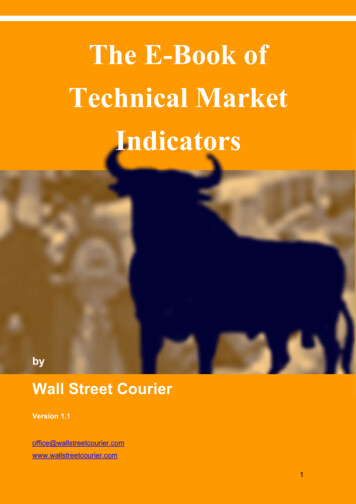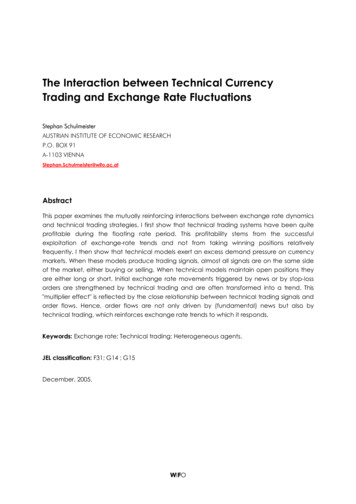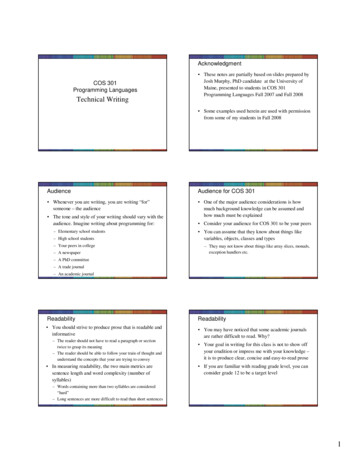
Transcription
The E-Book of Technical Market Indicatorswww.wallstreetcourier.comThe E-Book ofTechnical MarketIndicatorsbyWall Street CourierVersion er.comPage 1
The E-Book of Technical Market Indicatorswww.wallstreetcourier.comPrefaceThe transparency of the American markets offers an array of indicators and allowsdeep insights of prevailing sentiment. You find the activities of NYSE members likespecialists and floor traders, public and odd lot short sales, the Short Interest Ratio as wellas the large block transactions of the institutional investors published every week. Othertools for technical analysis include trend indicators, daily advances and declines, daily newhighs and lows, volume, indices, put/call ratios and other useful information like Stochastics,RSI, MACD, TICK and more. The problem is only that all these indicators contradict eachother most of the time. Countless books have been written on this subject, and no matterhow many will be written in the future: always be aware that there is no such thing as theHoly Grail of the stock market. But some people are more successful than others and theanswer is quite simple:No indicator is right all the time and you don't have to be right all the time. Just beright a higher percentage of the time than wrong. Choose some reliable indicators and stickto them. Don't follow some indicators for a while and switch to some others if they fail. Don'tbe a technician in the first half of the year and a fundamentalist the next half. Be consistentand disciplined in your approach. Don't abandon a good indicator because you think thistime everything is different.It takes of course a lot of guts because the opinions of the most widely quoted gurusof Wall Street are usually contrary to your indicators at that time. This is much easier if youdon't use margin. You will sleep a lot better if you buy fifty shares of IBM with the moneyyou can spare than two hundred shares on credit.Happy TradingWall Street Courierwww.wallstreetcourier.comPage 2
The E-Book of Technical Market Indicatorswww.wallstreetcourier.comTable of ContentAdvance-Decline Indicators .5Advance-Decline Line .5Advance-Decline Ratio.7Upside-Downside Volume Ratio .8Upside-Downside Volume Line .9Upside-Downside Volume Net Difference .11Advance-Decline Net Difference .12Global Futures Advance-Decline Index.13Global Futures Upside-Downside Volume Index.13Market Indicators .14High-Low Differential Index .14High-Low Ratio .15Global Futures High-Low Index.16Global Futures Bottom Indicator .16Cycles .19Large Block Index .19Short Term Trading Index (ARMS Index or TRIN) .20Trend Indicator .22CBOE Volatility Index (VIX).23Index Options Put/Call Ratio .23Call/Put Ratio .24Global Futures Put/Volume Ratio.25Smart Money Flow Index .26Global Futures Timing Indicator .27Global Futures Market Timer Index.28Global Futures Fear Indicator .29Wall Street Courier Index .29Global Futures Trading Index.30Global Futures Speculation Index .31Program Trading .32Calendar Spread .33Odd-Lot Differential Index .34Page 3
The E-Book of Technical Market Indicatorswww.wallstreetcourier.comShort Sales Statistics.35The NYSE Short Interest Ratio .35Odd-Lot Short Sales Ratio .36Floor Traders Short Sales Ratio.36Specialist Short Sales Ratio.37NYSE Member Short Sales Ratio .38Public Short Sales Ratio .38Odd-Lot Balance Index .39Odd-Lot/Floor Trader Short Sales Ratio.40Global Futures Odd-Lot/Specialist Short Sales Ratio.40Global Futures Public/Member Short Sales Ratio .41Public/Specialists Short Sales Ratio .42High readings indicate heavy shorting by the public (the so called crowd) and thereforebottoms, low readings indicate tops. .42Global Futures NYSE Member Trading Indicator .43Sentiment Indicators.44Investor Sentiment .44Commitments of Traders Report .46Appendix.48Dow Jones Industrial.48S&P 500.48Risk Statement .49Page 4
The E-Book of Technical Market Indicatorswww.wallstreetcourier.comAdvance-Decline IndicatorsAdvance-Decline LineThe Advance-Decline Line is a market breadth indicator and should be compared tothe other market indices like the Dow Jones or S&P 500. Daily or weekly NYSE data isused in the calculation. Because the Advance-Decline Line reflects the action of the generalmarket, any divergences are watched closely by market technicians. As long as the Dowand the Advance-Decline Line are moving in the same direction the trend will continue. Ifthe Dow makes a new high which is not confirmed by a high of the Advance-Decline Line,caution is warranted. Vice versa, if the Dow makes a new low and the Advance-DeclineLine doesn't you should cover your short sales. WallStreetCourier.com160000ADVANCE - DECLINE LINE -05-18100000To calculate your own weekly Advance-Decline Line is very simple and you canbegin your calculations at any time. Just pick a large enough base number like 100000.Then you calculate each week (or day) the difference between advances and declines byadding the advances and subtracting the declines. If you have 1269 advances and 1457declines on your first week, the reading of your newly created weekly Advance-Decline Linewould be 99812 (example below).Page 5
The E-Book of Technical Market 512911489104311761011759A-D 7102713102826102524103105103415104060105204The Advance-Decline Line gave a useful example in 1999. During the strong bullmarket the advance was quite broad and the A/D Line moved in tandem with the Dow. Butwhen the Dow made new highs in the beginning of 1999 the A/D Line was already laggingbehind, indicating a weakening of the general market. Internet mania and technology crazekept the market going for a while.Page 6
The E-Book of Technical Market Indicatorswww.wallstreetcourier.comAdvance-Decline RatioThe Advance-Decline Ratio is also market breadth indicator. It is calculated bydividing the number of advancing issues by the number of declining issues using daily orweekly NYSE data. It works very well as an overbought/oversold indicator and as amomentum indicator. A moving average should be used to smooth out the 5114813486921191187584512911489104311761011759A/D * 10010-Week 143158This chart shows you the weekly NYSE Advance-Decline Ratio on a 10-week movingaverage. Readings below 90 indicate intermediate bottoms and readings above 170 tops. WallStreetCourier.com2,40ADVANCE-DECLINE RATIO10-DAY MOVING -2700-12-2201-02-1601-04-1301-06-080,40Page 7
The E-Book of Technical Market Indicatorswww.wallstreetcourier.comUpside-Downside Volume RatioThe Upside-Downside Volume Ratio is also market breadth indicator. It is calculatedby dividing the volume of advancing issues by the volume of declining issues, using daily orweekly NYSE data. It works very well as an overbought/oversold indicator and as well as amomentum indicator. A moving average should be used to smooth out the 5.08.9501.09.9508.09.95Adv. 08468733204565588796723629338727349746298 WallStreetCourier.com180Decl. 10-Week 26135UPSIDE/DOWNSIDE VOLUME 05-1880Page 8
The E-Book of Technical Market Indicatorswww.wallstreetcourier.comUpside-Downside Volume LineThe Upside-Downside Volume Line is a market breadth indicator and should becompared to the other market indices like the Dow Jones or S&P 500. Daily or weeklyNYSE data is used in the calculation. Because the Upside-Downside Volume Line reflectsthe action of the general market, any divergences are watched closely by markettechnicians. As long as the Dow and the Upside-Downside Volume Line are moving in thesame direction the trend will continue. If the Dow makes a new high which is not confirmedby a high of the Upside-Downside Volume Line, caution is warranted. It is more affirmativethan the Advance-Decline Line and it gave a perfect sell signal in January 2000, when theDow made a new high and the Upside-Downside Volume Line lagged behind (chartsbelow). Vice versa, if the Dow makes a new low and the Upside-Downside Volume Linedoesn't, you should cover your short sales. To calculate your own weekly Upside-DownsideVolume Line is very simple and you can begin your calculations at any time. Just pick alarge enough base number like 1000000. Then you calculate each week (or day) thedifference between the upside volume and downside volume by adding the volume ofadvancing issues and subtracting the volume of declining issues. If you have an upsidevolume of 673210 and a downside volume of 732827 on your first week, the reading of yournewly created weekly Upside-Downside Volume Line would be 940383 (example 5.08.9501.09.9508.09.95Upside 08468733204565588796723629338727349746298Downside 84579703285669580615752603130553140418632U-D Volume 63016832Page 9
The E-Book of Technical Market Indicatorswww.wallstreetcourier.comHere is a beautiful example of the Upside-Downside Volume Line. Volume movesthe markets and this indicator gave a perfect sell signal in December 1999, when the Dowmade a new high and the Upside-Downside Volume Line didn't. It would have kept you alsoon the right side of the market right to the top. WallStreetCourier.com25000000ADVANCE - DECLINE VOLUME 0-0600-12-0101-01-2601-03-2301-05-181000000 WallStreetCourier.com12000DOW JONES WEEKLY 12-0101-01-2601-03-2301-05-185000Page 10
The E-Book of Technical Market Indicatorswww.wallstreetcourier.comUpside-Downside Volume Net DifferenceAnother method used by market technicians is to calculate the net differencebetween the upside- and downside volume. Daily or weekly data can be used. The netdifference between upside- and downside volume is calculated weekly and the result isadded. To smooth out the swings, a 10-week moving average should be applied. Belowthere is an example for weekly calculations:DateAdv. 298 WallStreetCourier.com1000000Decl. 84579703285669580615752603130553140418632Net 381851141177013077781488749151495716891662016832UP - DOWNVOLUME NET 3-2301-05-18-1000000Page 11
The E-Book of Technical Market Indicatorswww.wallstreetcourier.comAdvance-Decline Net DifferenceAnother method used by market technicians is to calculate the net differencebetween advances and declines. Daily or weekly data can be used. The net differencebetween advances and declines is calculated weekly and the result is added. To smoothout the swings, a 10-week moving average is applied. Below there is an example for 61011759Net Differ. Cumulative 10-Week 45955593,011441789727,8The chart went from extremely overbought in July 1997 to heavily oversold in September1998: 2000ADVANCE - DECLINE NET -2601-03-2301-05-18-1500Page 12
The E-Book of Technical Market Indicatorswww.wallstreetcourier.comGlobal Futures Advance-Decline IndexThis indicator is calculated by dividing the weekly number of advances and declines by thenumber of total issues traded. A 10-week moving average is applied to smooth out theswings. WallStreetCourier.com0,60ADVANCE - DECLINE INDEX -12-0101-01-2601-03-2301-05-180,30Global Futures Upside-Downside Volume IndexThis indicator is calculated by dividing the weekly upside and downside volumes by theweekly total volume. A 10-week moving average is applied to smooth out the swings. WallStreetCourier.com0,560,540,52UPSIDE - DOWNSIDE VOLUME INDEX WEEKLYUPSIDE VOLUME0,500,480,460,440,42y0,400,38DOWNSIDE ge 13
The E-Book of Technical Market Indicatorswww.wallstreetcourier.comMarket IndicatorsHigh-Low Differential IndexLike the advance-decline line, the high-low indicators produce signals when theydiverge from the action of the indices like the Dow Jones or the S&P 500. It is consideredunhealthy for the market climate if the indices make new highs without many stocksreaching new highs at the same time. Chart technicians use various methods to spotdivergences from the major market indices.The High-Low Differential Index produces good longer term signals when it divergesfrom the action of the Dow over a prolonged period of time. Daily or weekly data may beused and the calculation of this indicator is very simple; just subtract the daily or weeklynew lows from the new highs to get the differential and apply a moving average to smoothout the swings. If you have 479 new highs and 31 new lows on your first week, the readingof your newly created weekly High-Low Differential Index would be 448 (example 136029028529034749962110-week MA387371367358383399Page 14
2-0101-01-2601-03-2301-05-18The E-Book of Technical Market Indicators WallStreetCourier.com1500 -LOW DIFFERENTIAL INDEX10005000-500-1000-1500High-Low RatioThe High-Low Ratio is the number of new highs divided by the numbers of new lows. Dailyor weekly data may be used in the calculation. Readings do get sometimes very distorted ifthere are for instance about 600 new highs and 5 new lows or vice versa. A long-periodmoving average should therefore be applied.HIGH-LOW RATIO WEEKLY181614121086420Page 15
The E-Book of Technical Market Indicatorswww.wallstreetcourier.comGlobal Futures High-Low IndexThis indicator is calculated by dividing the weekly number of highs and lows by thenumber of total issues traded. A 10-week moving average is applied to smooth out theswings. Like the advance-decline line, this indicator produces signals when it diverges fromthe action of the indices like the Dow Jones or the S&P 500. It is considered unhealthy forthe market climate if the indices make new highs without many stocks reaching new highsat the same time. WallStreetCourier.comHIGH -LOW INDEX0,2510- WEEK MOVING 01Global Futures Bottom IndicatorThe Global Futures Bottom Indicator was developed by R. Koch of Wall StreetCourier. To our knowledge there is no previous mentioning of this indicator in any financialpublication. It does not appear very often but it is extremely reliable when the market is at aturning point. It prevents long-term investors from buying at the wrong time and worksespecially well for option traders because of its incredibly perfect timing. Unfortunately thisindicator does not tell you when to sell. Set yourself a limit if you trade options, or usetrailing stop-loss orders if you are a long-term investor.Page 16
The E-Book of Technical Market Indicatorswww.wallstreetcourier.comCheck BARRON S every Monday for the weekly: CALLS ADVANCES CALLS DECLINES PUTS ADVANCES PUTS DECLINES (CBOE MARKET REPORT)It takes you only five minutes every week to calculate the Global Futures Bottom Indicator: Divide the number of calls advancing by the number of calls declining Divide the number of puts declining by the number of puts advancing Subtract the result of calls adv./decl. from the result of puts decl./adv. Plot the difference on a chart and ignore the decimal.ExamplePrev.WeekThis WeekCalls Adv. Calls Decl.2300011000900026000Unch.Puts Adv. Puts Decl.80007000250006000240008000Unch.100007000You calculate as follows:23000 : 11000 2,0925000 : 7000 3,57Difference 148 (357 minus 209)9000 : 26000 0,348000 : 24000 0,33Difference - 1 ( 33 minus 791219022844755421092193361274116547Calls 194051723711905145222018411238Puts 0,811,202,911,085614662321343419123285213749Page 17
The E-Book of Technical Market Indicatorswww.wallstreetcourier.com WallStreetCourier.comTHE GLOBAL FUTURES BOTTOM 101-01-2601-03-2301-05-18-25 WallStreetCourier.comTHE GLOBAL FUTURES BOTTOM 100-10-0600-12-0101-01-2601-03-2301-05-18-20,00Any zero or minus reading indicates a bottom. Since this indicator was invented anddeveloped it only failed twice on a minus reading if compared to the Dow Jones. This wasdue to panic selling on August 3rd and August 24th 1990 when Saddam invaded Kuwait. Readings between 1 and 5 are also very reliable and indicate intermediate bottomsin bull markets. Readings up to 25 may work but should be counterchecked with other indicatorssuch as the Global Futures Market Timing Indicator. Readings above 600 are good breadth indicators and show you that a powerfulmarket move on the upside is to be expected. Ignore all other readings.Page 18
The E-Book of Technical Market Indicatorswww.wallstreetcourier.comFor your convenience there is a track record attached (377 kb) back to 1985 for youto check the value of this indicator. Plot the numbers on a chart and compare it withprevious market action. Feel free to make use of our indicator if you find it useful. Feel alsofree to publish it as long as you mention the source and call it the Global Futures BottomIndicator. Download the track record at indicators/track-record.htmCyclesCycle analysis has a long history and is also part of technical analysis. All marketsappear to be subject to cyclical patterns and forces caused by economic influences andcountless other factors. Stock market movements seem to take place with cyclical regularityand timing your trades to coincide with anticipated cyclical movements can be veryrewarding. Wall Street Courier offers some very reliable cycles for subscribers.Large Block IndexThe Large Block Index is calculated from the number of upticks and downticks inlarge block transactions of single trades of 10 000 shares and over. An uptick is at a pricehigher than the last previous trade and initiated by a buyer. A downtick is at a price lowerthan the previous trade and initiated by a seller. The rationale behind the Large Block Indexis quite simple. It measures activities and extremes in institutional sentiment and behavior.When the ratio of upticks rises to very high levels, it indicates that the institutions are buyingheavily, reaching a fully invested position and therefore lowering their cash reserves.Conversely, when the ratio of downticks rises to high levels, it indicates that theinstitutions are selling and are raising cash. When the institutional behaviour reachesextremes, the market will turn in a contrary direction. This indicator has often signaled majorreversals and has also prevented investors from plunging into the market at the wrong time.The chart below shows you this indicator on a 10-day moving average.Page 19
The E-Book of Technical Market Indicatorswww.wallstreetcourier.com WallStreetCourier.comTHE GLOBAL FUTURES LARGE BLOCK ,950,900,850,8010-DAY MOVING 499-01-0199-01-2999-02-2699
The E-Book of Technical Market Indicators www.wallstreetcourier.com Advance-Decline Indicators Advance-Decline Line The Advance-Decline Line is a market breadth indicator and should be compared to the other market indices like the Dow Jones or S&P 5











